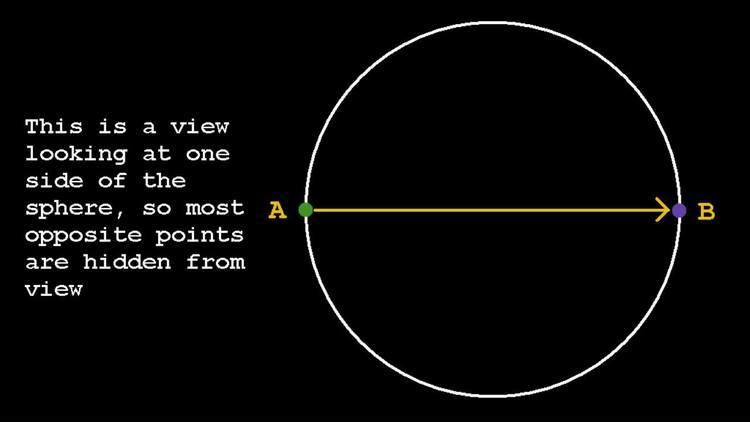 | ||
In mathematics, the Borsuk–Ulam theorem (BUT), states that every continuous function from an n-sphere into Euclidean n-space maps some pair of antipodal points to the same point. Here, two points on a sphere are called antipodal if they are in exactly opposite directions from the sphere's center.
Contents
- History
- Equivalent statements
- With odd functions
- With retractions
- 1 dimensional case
- General case algebraic topology proof
- General case combinatorial proof
- Corollaries
- Equivalent results
- Generalizations
- References
Formally: if
The case
The case
BUT has several equivalent statements in terms of odd functions. Recall that
History
According to Matoušek (2003, p. 25), the first historical mention of the statement of BUT appears in Lyusternik & Shnirel'man (1930). The first proof was given by Karol Borsuk (1933), where the formulation of the problem was attributed to Stanislaw Ulam. Since then, many alternative proofs have been found by various authors, as collected by Steinlein (1985).
Equivalent statements
The following statements are equivalent to BUT.
With odd functions
A function
BUT is equivalent to the following statement: A continuous odd function from an n-sphere into Euclidean n-space has a zero. PROOF:
With retractions
Define a retraction as a function
BUT is equivalent to the following claim: there is no continuous odd retraction.
PROOF: If BUT is correct, then every continuous odd function from
Conversely, if BUT is incorrect, then there is a continuous odd function
since
1-dimensional case
The 1-dimensional case can easily be proved using the intermediate value theorem (IVT).
Let
General case - algebraic topology proof
Assume that
One can also show the stronger statement that any odd map
General case - combinatorial proof
BUT can be proved from Tucker's lemma.
Let
Define a triangulation of
Because g is odd, the labeling is also odd:
The above is true for every
Corollaries
Equivalent results
Above we showed how to prove BUT from Tucker's lemma. The converse is also true: it is possible to prove Tucker's lemma from BUT. Therefore, these two theorems are equivalent. There are several fixed-point theorems which come in three equivalent variants: an algebraic topology variant, a combinatorial variant and a set-covering variant. Each variant can be proved separately using totally different arguments, but each variant can also be reduced to the other variants in its row. Additionally, each result in the top row can be deduced from the one below it in the same column.
Generalizations
1. In the original BUT, the domain of the function f is the unit n-sphere (the boundary of the unit n-ball). In general, it is true also when the domain of f is the boundary of any open bounded symmetric subset of Rn containing the origin (Here, symmetric means that if x is in the subset then -x is also in the subset).
2. Consider the function A which maps a point to its antipodal point: A(x)=-x. Note that A(A(x))=x. The original BUT claims that there is a point x in which f(A(x))=f(x). In general, this is true also for every function A for which A(A(x))=x. However, in general this is not true for other functions A.
